Ratatouille
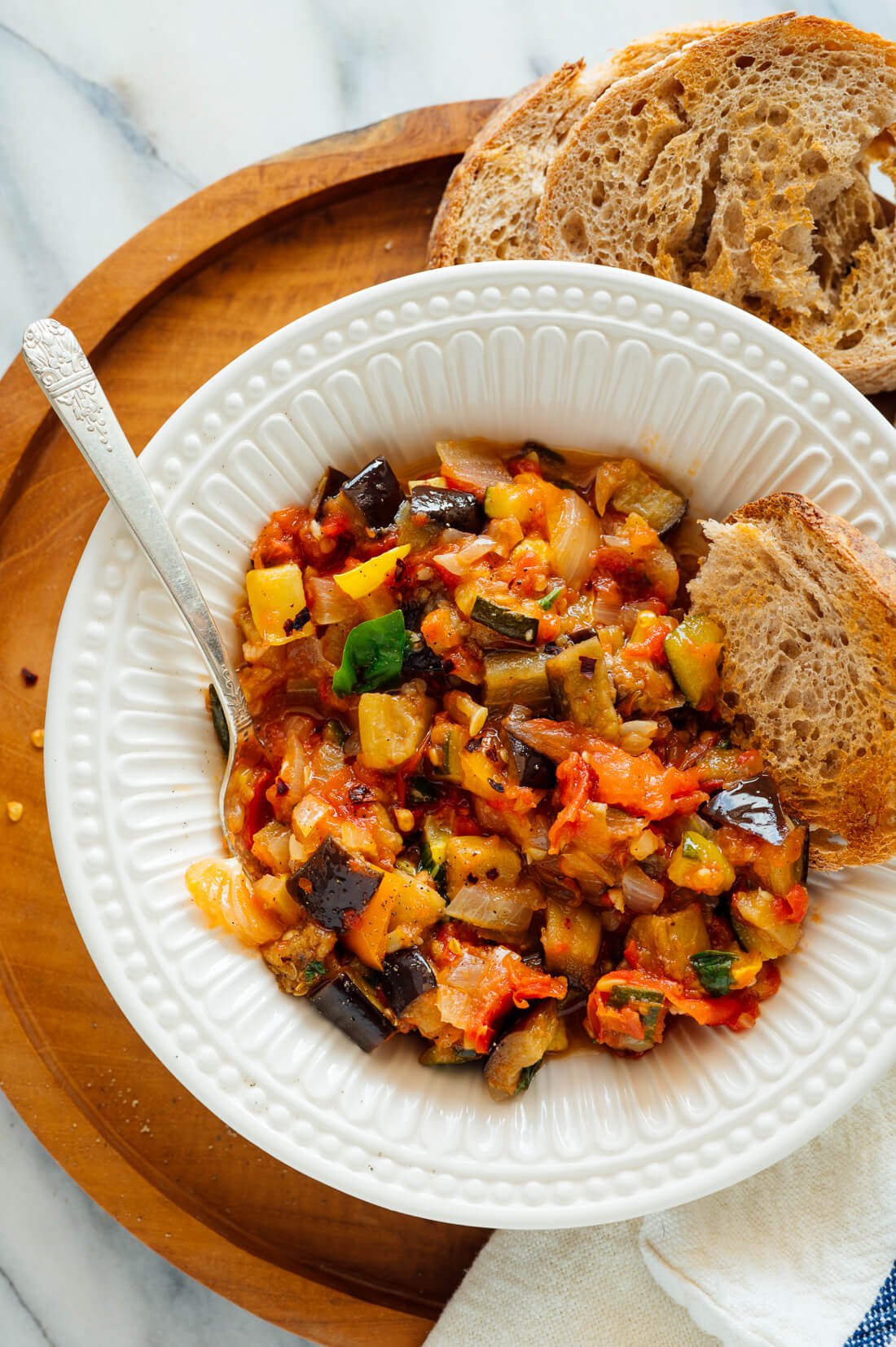
It’s ratatouille season! Ratatouille is a classic end-of-summer French stew that’s fun to say (rat-tuh-TOO-ee) and fun to make. It’s packed with fresh produce: tomatoes, eggplant, zucchini and yellow squash, and bell pepper.
This summer, we sampled authentic French ratatouille in Provence. I liked some ratatouille more than others, so I vowed to come up with my own favorite ratatouille recipe when I came home. Today is the day!
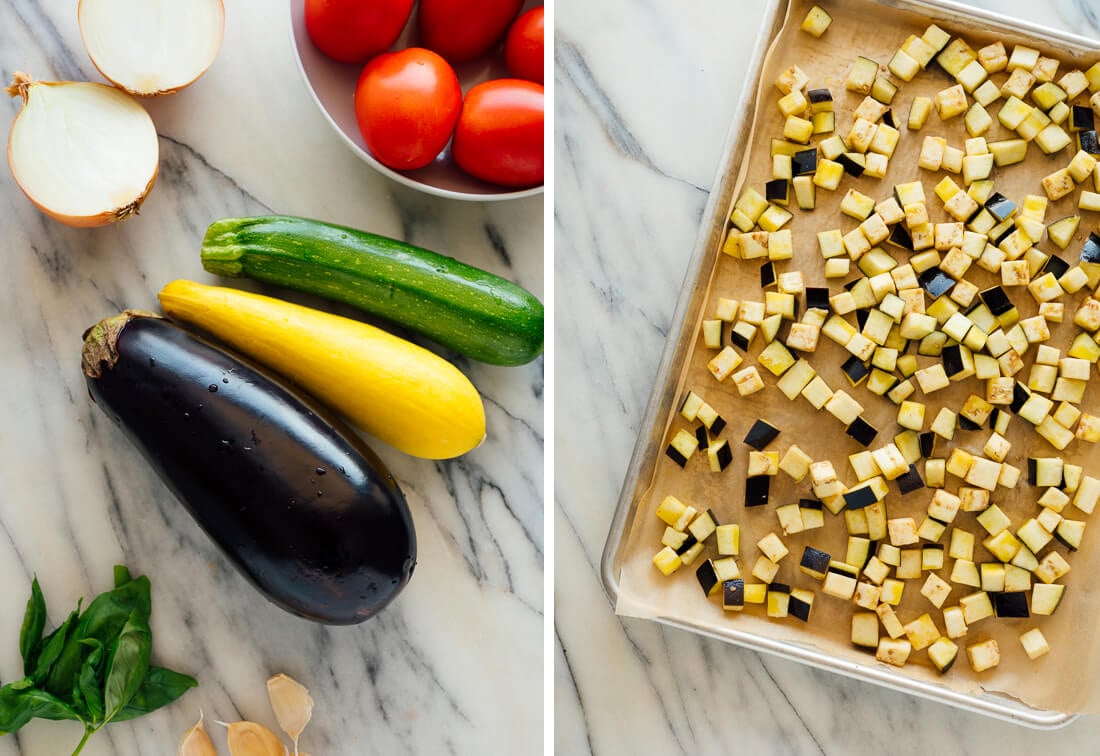
In Provence, ratatouille is typically cooked on the stove. Each vegetable is cooked in olive oil until it’s properly tender. In the end, all of the ingredients are combined and simmered to meld the flavors.
The French know how to cook, and this concept is definitely one to follow. Ratatouille combines a large volume of late-summer vegetables that have different cook times. If you tried to throw them all into a pot at once, none of the veggies would have a chance to caramelize, the eggplant would fall apart by the time the zucchini is tender, and your ratatouille would probably never meet its full potential.
This recipe is a little different. We’re going to roast the vegetables until they’re deliciously caramelized on the edges and a little dehydrated (no squeaky or mushy zucchini here). Then, we’ll add those perfectly roasted veggies to a simmering fresh tomato sauce.
This method yields amazing ratatouille. My husband says it’s the best he’s ever had. It’s also easier to make than proper stovetop ratatouille, since it requires less time standing over the stove. Hooray!
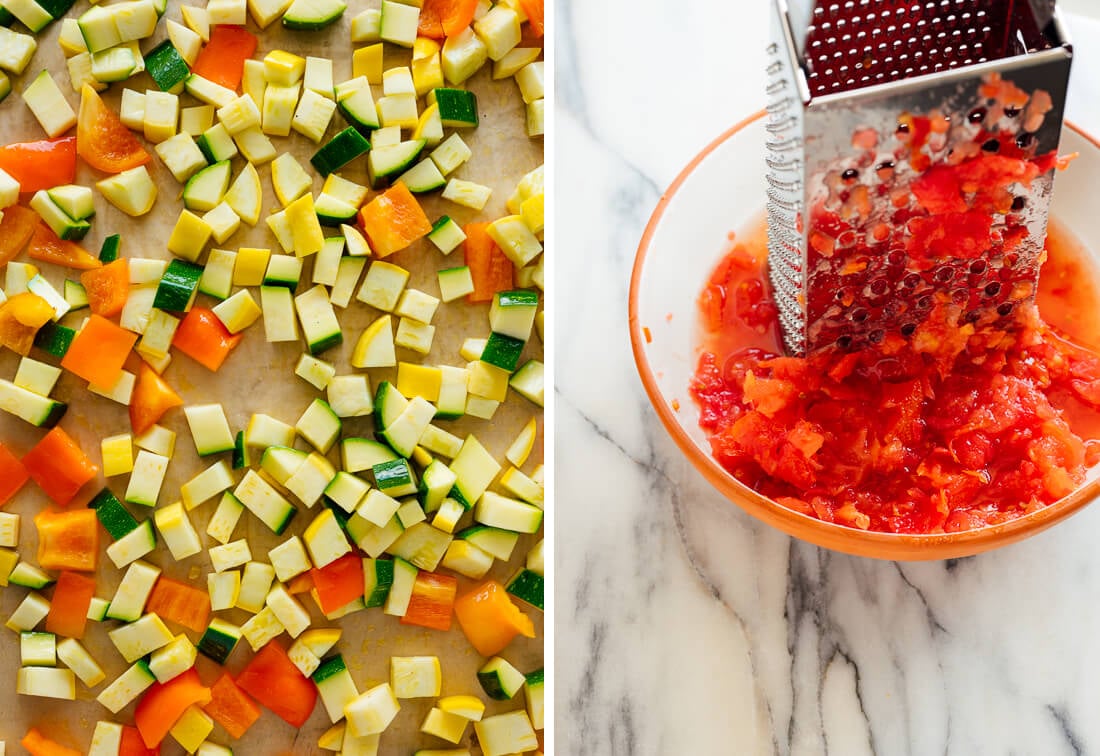
5 Reasons to Love Ratatouille
- It’s a great way to use up a surplus of late-summer veggies. If you come home from the farmers’ market with too much, make ratatouille.
- Ratatouille turns basic vegetables into magic. Even if you don’t typically love eggplant or summer squash, I bet you’ll enjoy this ratatouille.
- It’s vegan and gluten free for all to enjoy. Just choose your accompaniments accordingly.
- Ratatouille is a great make-ahead recipe. It tastes even better the next day and reheats beautifully. (You can also freeze extra ratatouille for later.)
- Make it a movie night and watch Disney’s Ratatouille!

Ratatouille Ingredients
This recipe features traditional ratatouille ingredients, which are:
Fresh Tomatoes
Fresh tomatoes are key for making ratatouille that tastes fresh and lively, not dull and heavy. We’ll grate the tomatoes (or blitz the in the food processor) and cook them with onion and garlic to make an irresistible tomato sauce.
I tried this recipe with canned tomatoes and it didn’t taste nearly as nice. You can do it if you have to (use one large 28-ounce can of crushed tomatoes), but fresh tomatoes really are best.
Eggplant
Eggplant is known for being difficult to prepare, but it’s easy to roast! No salting necessary. The oven takes care of everything.
Zucchini & Yellow Squash
I love the visual combination of green zucchini and yellow squash. If you want to use two of one type instead of both, no problem.
Bell Pepper
Take your pick from red, orange or yellow bell pepper.
Olive Oil
Extra-virgin olive oil deserves a shout-out. We’re only using as much as necessary, so this ratatouille is not greasy like some can be.
Tossing the vegetables lightly in oil raises their surface temperature, which helps us achieve those delicious caramelized edges. Finally, stirring a teaspoon of olive oil into the pot offers some extra richness and herbal flavor. Don’t skip it!
Fresh Basil & Seasonings
We’ll finish off our ratatouille with a handful of chopped basil, which livens up our stew with fresh flavor. We’ll also add a sprinkle of dried oregano—crumble it between your fingers as you add it to wake up the flavor. Then, add salt and pepper until your ratatouille tastes completely wonderful.
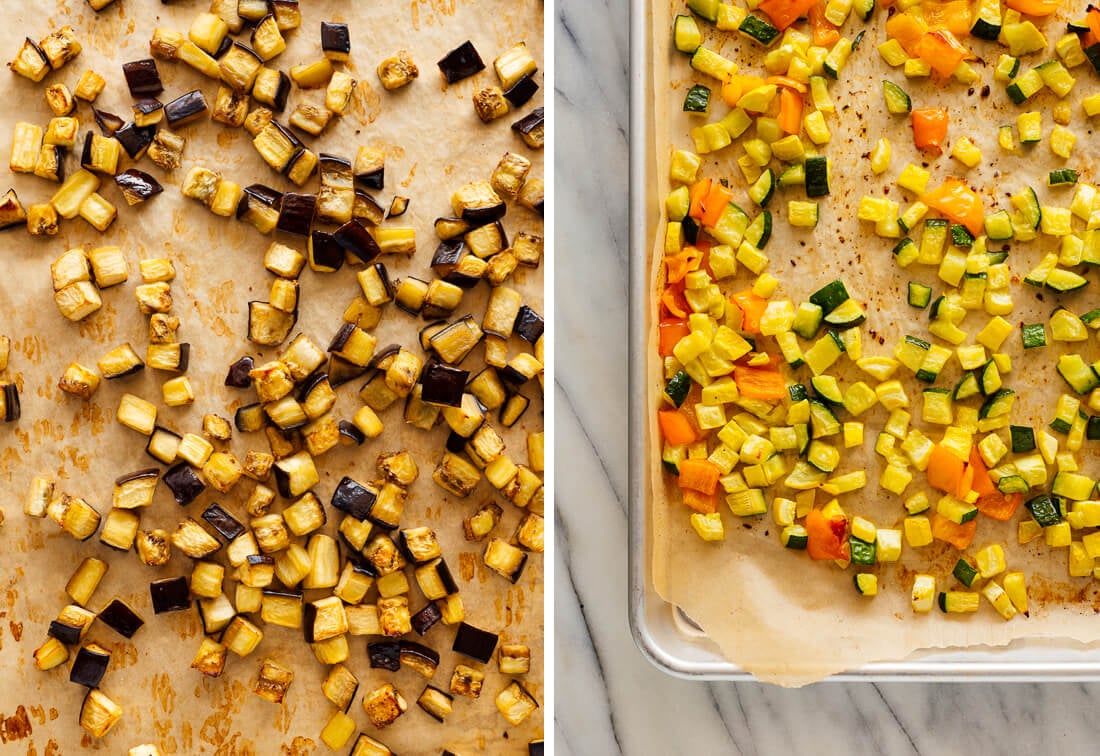
How to Make Ratatouille
You’ll find the full rundown in the recipe below. Don’t be intimidated by the length of the recipe—it’s not hard. Here’s the gist:
- Prep your veggies and preheat the oven.
- Toss the eggplant with olive oil and salt on one baking sheet, and the squash and bell pepper on another baking sheet. Arrange the vegetables in an even layer. (Using two pans gives the vegetables room to breathe and lets us split the veggies by cook times.)
- Bake both pans in the oven at once, stirring halfway. The eggplant will finish sooner than the other pan.
- Meanwhile, make a simple tomato sauce on the stovetop. Stir the roasted vegetables into the simmering tomato sauce as they’re ready.
- Lastly, add fresh basil and seasonings. Serve immediately, or let it cool to room temperature before refrigerating for later.

Ratatouille Serving Suggestions
Ok, one more reason to love ratatouille—you can serve it so many different ways! Here are a few ideas:
- Serve ratatouille as a stew, with crusty bread on the side. Toasted if you wish.
- Serve it over freshly cooked pasta. So good.
- Leftovers make a great breakfast. Just add cooked eggs: fried, scrambled or poached.
- Turn it into an appetizer by piling spoonfuls onto toasted baguette.
You might enjoy a sprinkle of grated Parmesan or mozzarella over any of the above.
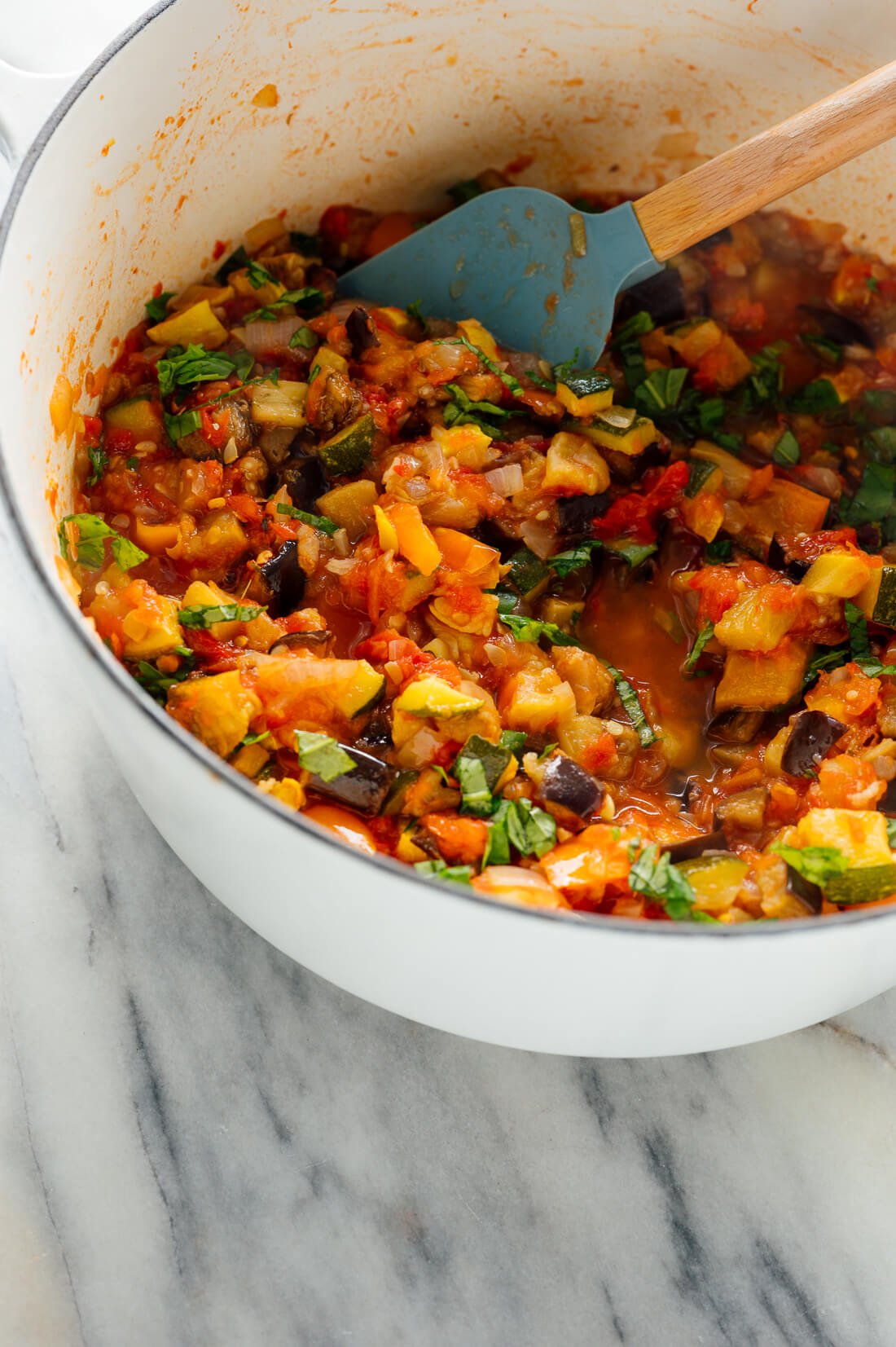
Suggested Equipment
You probably have the proper equipment in your kitchen already. Here’s what you’ll need (these are affiliate links):
- Two large, rimmed baking sheets for roasting your vegetables. These pans (called “half-sheet pans”) are the perfect size for roasting one pound of diced eggplant without overlap. They are what all professional recipe developers use, they’re inexpensive, and I swear by them.
- Cheese grater or food processor for breaking down the fresh tomatoes.
- Dutch oven or heavy-bottomed soup pot for the stovetop.
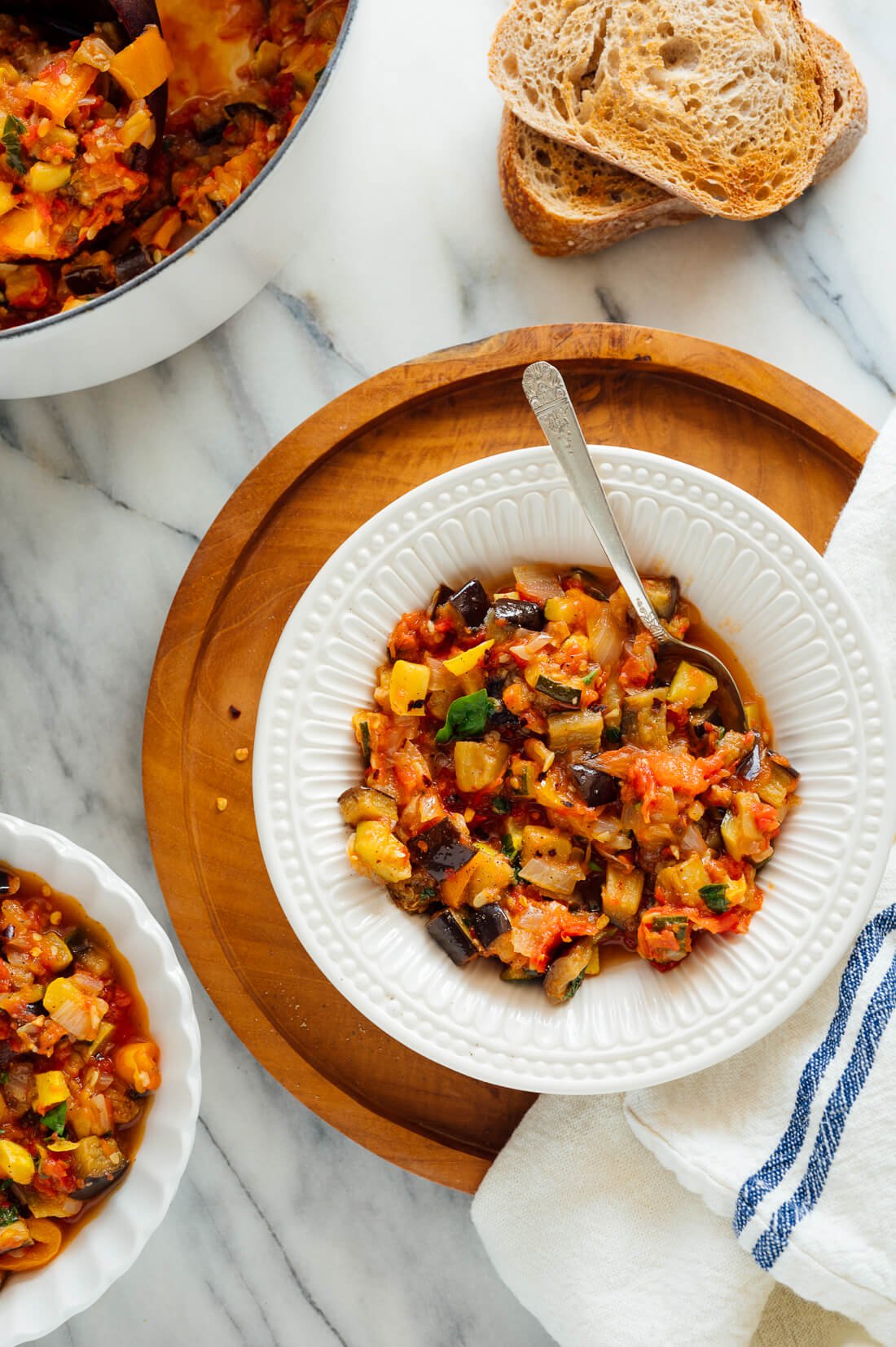
Please let me know how your ratatouille turns out in the comments! It’s a little labor intensive, as all good ratatouilles are, but I hope it proves 100 percent worth the effort.
Looking for more delicious late-summer recipes? Here are a few of my favorites:
- Layered Panzanella Salad
- Heirloom Caprese Salad
- Double Tomato Pesto Spaghetti with Zucchini Noodles
- Vegetable Paella
- Gluten-Free Peach Crisp
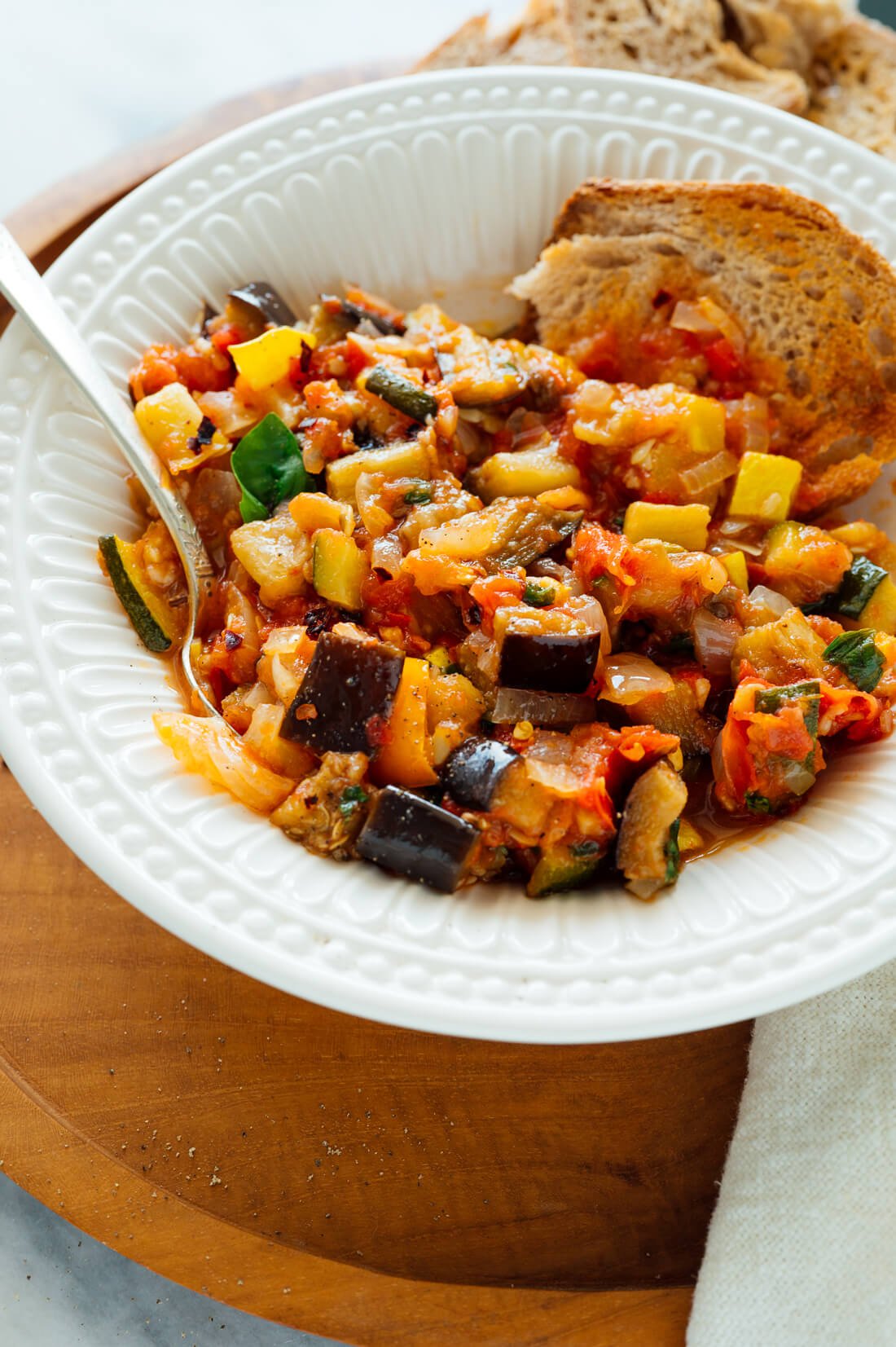
Ratatouille
- Author:
- Prep Time: 20 minutes
- Cook Time: 40 minutes
- Total Time: 1 hour
- Yield: 4 servings 1x
- Category: Stew
- Method: Roasted and stovetop
- Cuisine: French
Learn how to make the best French ratatouille with this foolproof recipe! The trick is to roast the vegetables, then add them to a simmering tomato sauce. Recipe yields 4 generous or 6 more modest servings.
Scale
Ingredients
- 2 pounds ripe red tomatoes (6 medium or 4 large)
- 1 medium eggplant (1 pound), diced into ½-inch cubes
- 1 large red, orange, or yellow bell pepper (about 8 ounces), cut into ¾-inch squares
- 1 medium-to-large zucchini (about 8 ounces), diced into ½-inch cubes
- 1 large yellow squash (about 8 ounces), diced into ½-inch cubes
- 5 tablespoons + 1 teaspoon extra-virgin olive oil, divided
- ¾ teaspoon fine sea salt, divided, more to taste
- 1 medium yellow onion, chopped
- 4 cloves garlic, pressed or minced
- ¼ cup chopped fresh basil
- ¼ teaspoon red pepper flakes, more or less to taste
- ¼ teaspoon dried oregano
- Freshly ground black pepper, to taste
Instructions
- Preheat the oven to 425 degrees Fahrenheit with one rack in the middle of the oven and one in the upper third of the oven. Line two large, rimmed baking sheets with parchment paper for easy clean-up, if desired.
- To prepare your tomatoes, remove any woody cores with a paring knife. Then, grate them on the large holes of a box grater into a bowl (this is easiest if you hold the tomato at a diagonal), and chop any remaining tomato skin. Or, blitz the tomatoes in a food processor until they are broken into a frothy pulp. Set aside.
- On one baking sheet, toss the diced eggplant with 2 tablespoons of the olive oil until lightly coated. Arrange the eggplant in a single layer across the pan, sprinkle with ¼ teaspoon of the salt, and set aside.
- On the other baking sheet, toss the bell pepper, zucchini and yellow squash with 1 tablespoon of olive oil and ¼ teaspoon salt. Arrange the vegetables in a single layer. Place the eggplant pan on the middle rack and the other vegetables on the top rack. Set the timer for 15 minutes.
- Meanwhile, warm 2 tablespoons of the olive oil in a large Dutch oven or soup pot over medium heat. Add the onion and ¼ teaspoon salt. Cook, stirring occasionally, until the onion is tender and caramelizing on the edges, about 8 to 10 minutes.
- Add the garlic, stir, and cook until fragrant, about 30 seconds. Add the tomatoes, and use a wooden spoon or sturdy silicone spatula to stir any browned bits stuck to the bottom of the pan into the mixture. Reduce the heat to medium-low, or as necessary to maintain a gentle simmer.
- Once 15 minutes are up, remove both pans from the oven, stir, and redistribute the contents of each evenly across the pans. This time, place the eggplant on the top rack and other vegetables on the middle rack.
- Bake until the eggplant is nice and golden on the edges, about 10 more minutes (the eggplant will be done sooner than the rest). Remove the eggplant from the oven, and carefully stir the eggplant into the simmering tomato sauce.
- Let the squash and bell pepper pan continue to bake until the peppers are caramelized, about 5 to 10 more minutes. Then, transfer the contents of the pan into the simmering sauce. Continue simmering for 5 more minutes to give the flavors time to meld.
- Remove the pot from the heat. Stir in 1 teaspoon olive oil, the fresh basil and red pepper flakes. Crumble the dried oregano between your fingers as you drop it into the pot. Season to taste with additional salt (I usually add ¼ teaspoon more) and black pepper.
- Serve in bowls, perhaps with a little drizzle of olive oil, additional chopped basil, or black pepper on top (all optional). Like all stews, this ratatouille’s flavor improves as it cools. It’s even better reheated the next day. Ratatouille keeps well in the refrigerator, covered, for 4 days, or for several months in the freezer.



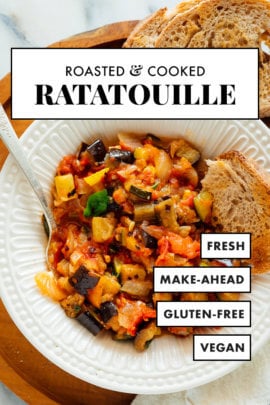
Comments are closed.